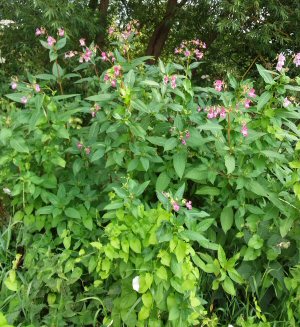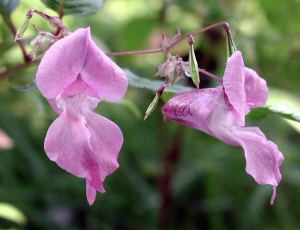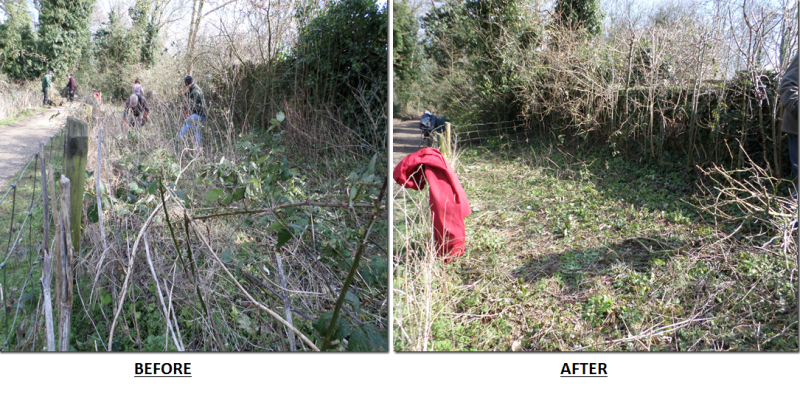Newsletter
Current
Previous
|
August 2018
|
|
|
|
|
EARLEY: No longer a small hamlet,
but one unavoidably connected globally.
A couple of hundred years or so ago local Earley people would have dealt with many problems - the vagaries of the weather, whether the harvest would provide enough food, etc. - but they could not have imagined those we now have to deal with: climate change, oceans awash with plastic, and the negative effects of alien plants.
 Whilst the arrival of new plants and animals has been occurring over centuries, the more recent introduction of non-indigenous animals and plants, lacking controlling predators, has wreaked havoc on our established wildlife. One well-known example imported by the Victorians, the grey squirrel , which is naturally part of the North American Forests ecosystem, has been a destructive presence in our woods and to our native red squirrel. Whilst the arrival of new plants and animals has been occurring over centuries, the more recent introduction of non-indigenous animals and plants, lacking controlling predators, has wreaked havoc on our established wildlife. One well-known example imported by the Victorians, the grey squirrel , which is naturally part of the North American Forests ecosystem, has been a destructive presence in our woods and to our native red squirrel.
One such alien plant is the Himalayan Balsam - as its name implies, a native of the Himalayas. The plant was first introduced in 1839 when seeds from Kashmir were given by Dr. Royle to Kew, and it subsequently escaped from gardens into the countryside, having a destructive effect on our local riverbank wildlife.
|
|
|
|
|
The Biological Control of Himalayan Balsam
A talk to the EEG by Dr Carol Ellison, 21 May 2018
In his introduction, Alan Broodbank mentioned a group of people risking stinging nettles to pull up and destroy beautiful plants: a reference to the Wednesday volunteers clearing invasive Himalayan Balsam. He then welcomed Carol Ellison, Principal Scientist at the Commonwealth Agricultural Bureau (CABI), and a former colleague of his. Carol has 25 years’ experience in biological control, and has also appeared on Gardener’s World. CABI, established in 1910, is a not-for-profit, inter-governmental organisation, with 48 member-countries, mainly from the Commonwealth, but now including other countries. CABI’s 500 employees worldwide undertake scientific publishing, communication and consultancy.
 Himalayan Balsam Himalayan Balsam
Himalayan Balsam was introduced into Britain as an ornamental plant for stately homes, but it has spread throughout the surrounding riversides and woodland, so that it is now a pest. The plants produce 5000 seeds per square metre, and germinate early (at 4oC). In spreading, it competes with native plants for light and space and, along the river bank, contributes to silting and flooding. The economic damage caused by Himalayan Balsam is estimated at £1.7bn per annum, and the Environment Agency spends £300,000 per annum on its removal. The UK is the worst-affected country in Europe; Switzerland is second.
Biological Control
Many introduced species of flora or fauna flourish in a new location because of a lack of the natural predators or diseases which occur in their native habitat. To restore the natural balance, biological control methods have been developed, to release some of their native adversaries into the adoptive territory. Himalayan Balsam is much more vigorous in Britain: plants in its native range (from Kashmir to NW Nepal) are smaller, and suffer more from pests and diseases.
To find a biological control for Himalayan Balsam, CABI looked for natural enemies and tested for any specific to the target plant, so as not to damage native plants. A control known as rust was found, which affects Himalayan Balsam. The five stages of its development mirror the life-cycle of the Balsam. CABI then checked and confirmed its host specificity to meet quarantine requirements. Of the 75 native plant species checked, only two species of impatiens were susceptible. As the risk was considered slight, the programme went ahead.
After a Pest Risk Assessment, in 2014, CABI was licensed to release the rust, to establish whether it would survive in the UK. It was then released at 25 sites during 2014 - 16, including the North-East, Yorkshire, the Gower peninsula and Berkshire. As its spread was limited by 2015, CABI made further checks on climate conditions.
DNA studies
Tests for genetic variation indicated more than one introduction, so infection rates varied according to the respective gene pool. A new, additional strain of rust was selected, from Pakistan rather than India. When further tests showed that a site in Wales was resistant to the Indian strain, but susceptible to the Pakistani one, a study of DNA from the Natural History Museum proved there are three strains of Himalayan Balsam in the UK, all from Kashmir.
In 2016, rust was released at two sites, Gatwick and Lampeter, and showed excellent infection rates. A permit to spray has now been applied for, and volunteers are being sought to help with the task. Local action groups were involved at 21 sites during 2017, but the project will not be fully established for some years.
Edwin A.R. Trout
(Picture of Himalayan Balsam flower from ukwildflowers.com.)
|
|
|
Community orchard news, July 2018
Since my last report, there was a pruning session in late January, to encourage all the trees to put on some growth. We were rewarded with a good show of blossom after the ‘Beast from the East’ had passed through, and all went well for a time.
That changed in June and July, unfortunately. On the first occasion in June, an apple tree and the Erlegh Elfins’ plum tree were both uprooted; although the apple tree was retrieved, repaired and replanted, there was no sign of the plum tree (but read on!). Later in the month, the netting and fence posts for a pear tree which had been cut down almost to the rootstock were removed: the fence posts were sawn off, so this was a deliberate act, rather than an accident. In July, the orchard notices were damaged, with one post sawn off and the other broken, and the metal supports for them badly damaged. While one of the orchard group was removing these from the scene, however, an Owston resident came out to say that she had found the plum tree abandoned on her garden 3 weeks before, and had taken it in and potted and watered it. She was relieved to hand it over to someone else, and it has now been repotted and put in a shady spot, while we see if it will recover from its ordeal.
One committee member has been watering the mulberry tree (uprooted twice, but replanted) and the damaged apple tree during this hot spell, and some of the Wednesday volunteers and committee members have watered all the trees during a Wednesday session.
In the meantime, we have written to councillors and officers of WBC and ETC to alert them to the on-going problems, and we have reiterated a long-standing request to WBC to reduce the height of the laurel hedges, to help with security.
On a more positive note, several of the trees are now bearing fruit, and we hope for rain soon to help with their growth!
Jean Hackett
|
|
|
Jordan's Apple Cake recipe
(How to make use of your apples - a recipe from Jean)
 Ingredients for sponge base Ingredients for sponge base
5 oz/125g wholewheat SR flour, or w/w plain flour + 1tsp baking powder
4 oz/100g butter or vegetable margarine
2 eggs
4 oz/100g brown sugar
Water or fruit juice to mix
Ingredients for topping
2 large cooking or tart eating apples (ideally, windfalls)
1 dessertspoon brown sugar
1 tsp cinnamon
Heat oven to 180 degrees (?160 for fan oven)/gas Mark 4.

- Cream fat and sugar; beat in eggs gradually.
- Fold in flour (and baking powder, if used), plus a little water or fruit juice to make soft mixture. Pour into greased, base-lined square or oblong tin (recipe suggests Swiss roll tin, but I use deep square tins or 2 sandwich tins).
- Cut apples into quarters; peel, core and trim. Slice finely into crescents.
- Arrange slices in overlapping rows to cover top of cake mix. Mix brown sugar and cinnamon, and sprinkle over apples. Bake for 25 – 30 minutes, until cake mix is cooked.
- Cool on rack; cut into slices, following lines of apples, to whatever size you like.
I usually freeze mine in the tin uncut, or cut in 2 pieces only.
(I’ve never tried it, but an alternative to the apples is to add 1 oz/25g chopped walnuts and dates to cake mix, and omit topping.)
|
|
|
 Maiden Erlegh Nature Reserve walk on 15th July, led by Grahame, Head Park Ranger for Earley Town Council (on right of photo) Maiden Erlegh Nature Reserve walk on 15th July, led by Grahame, Head Park Ranger for Earley Town Council (on right of photo)
The reserve lies in the heart of Earley, and is a haven for both people and wildlife. It contains ancient woodland, with several veteran oaks, a man-made lake which is a habitat for water birds, and areas of meadow.
Check our website, newsletters and local posters for future walks and talk - everyone welcome.
|
|
|
Anne and John Booth have been regularly monitoring the appearance of local wild orchids
 Good News: this year on their annual check they found 336 pyramidal orchid flowering spikes. This is the largest number since the start of the count in 2011. Good News: this year on their annual check they found 336 pyramidal orchid flowering spikes. This is the largest number since the start of the count in 2011.
Sad News: no bee orchids this year.
Click on the picture for a larger version
|
|
More news from Anne and John on Kennet Mouth and Broken Brow – Mass Rapid Transit and Park & Ride
Bad news, good news, bad news, and hope …
On 30th June Reading approved its own planning application for the £24 million ‘bus lane on stilts’ (a.k.a. East Reading Mass Rapid Transit) but on 25th July Wokingham’s Planning Committee rejected it saying:
“The proposed MRT link, including bridge structure, due to its height and scale and its prominent and sensitive location, particularly its proximity to the River Thames and River Kennet, would be harmful to the landscape character of the area including its riparian appearance. This would be contrary to policies CP1, CP3 and CP11 of the Core Strategy.”
At the Wokingham meeting Bulmershe and Whitegates Ward Councillors Shahid Younis, Andy Croy and Carl Doran all spoke against the proposal. Councillors had visited the site a few days earlier and found it very attractive; they concluded they ‘must do better than this’ for the riverside environment, and rejected it by five votes to four.
Now Reading Borough Council say they will submit a new, revised planning application - addressing the main concerns raised by Wokingham councillors - this autumn. It will then be considered by both Wokingham and Reading Planning Committees in spring next year.
It is hard to see what significant changes could be made. One of the two beautiful Weeping Willows by the Kennet (both listed by Wokingham District Veteran Tree Association) and many of the attractive line of Hawthorn trees by the tow-path must surely be lost. In the last set of changes to ‘save’ the other Willow, the proposal seemed to be to remove half its crown, completely disfiguring it. People living in one of the most densely populated areas of East Reading will be most affected – this is their ‘green lung’.
 Reading are now going to investigate ‘demand management’ measures to address congestion and air quality – reduced congestion should provide faster bus journeys at much less cost that the MRT. Reading are now going to investigate ‘demand management’ measures to address congestion and air quality – reduced congestion should provide faster bus journeys at much less cost that the MRT.
Campaigners hope Wokingham will now stop spending money developing the Park and Ride site (for which they have permission and funding) behind the Waterside Centre. Without the bus lane it will be much less attractive, and traffic using it will worsen congestion at Suttons roundabout.
Links: SOAR Website (under development):
Wokingham Core Strategy
|
|
|
EARLEY'S WEDNESDAY VOLUNTEER GROUP has been busy in Maiden Erlegh Nature Reserve, as you can see from Sue Smith's photos. Nature sometimes needs a bit of TLC. This is just a sample of the many jobs they carry out (see reference to the group above).
|
|
|
NEWS FROM BEYOND EARLEY
The Government has announced plans for a deposit return scheme for plastic bottles. Perhaps this may be the answer for Jahvavi, who wrote the following story. Like many youngsters, she obviously cares very much about the effects of plastic on our oceans.
“Once lurking up in the waters of an abandoned tropical Island, the fearsome creature followed the trail of clear, shiny objects which led him to a new world. There he saw skyscrapers tall enough to reach the sky and cars flooding the car-parks. The place was bustling with traffic. Noise deafened his ears. He noticed a human quenching his thirst from a similar shiny object that he had followed. Once he had finished the human recklessly dropped it in the shimmering sea (that added beauty to the environment). Steaming with rage, the creature spontaneously lashed its tentacles against the human flinging it in the air. He didn’t like the malicious idea of humans polluting his habitat. He had to stop it. But how…“
Jahnavi Garg
For children interested in the environment, the EEG Junior Group meets at Maiden Erlegh Interpretation Centre every second Saturday of the month. Ring Charlotte 07771 605825 for details.
EARLEY WILDLIFE SIGHTINGS AND GARDEN SURVEYS
BUTTERFLIES During May our garden surveyors, Gillian and Margaret, both noted the following butterflies: orange-tip, holly blue. Also recorded – Margaret: large white. Gillian: small white, red admiral, speckled wood.
BIRDS Breeding in May in garden. Margaret: blackbird, goldfinch. Gillian: blue tit, great tit. Gilllian had green woodpeckers visiting in May and June, and in June gt.spotted woodpecker.
Val’s Spring Notes : Another resident’s delight in nature is on the EEG website.
|
|
|
LOCAL FORTHCOMING EVENTS September to December 2018
|
|
Bits and pieces
Don't forget. We're on Facebook now!
The Earley Environmental Group now has a Facebook presence. We will be using this in addition to the main website, the Yahoo Group and the Newsletter as a way of keeping everyone up to date with our activities and to let you know about upcoming events. Members are also welcome to post news stories or any photographs relevant to the group. If you are a Facebook user, please do join up - just search for 'Earley Environmental Group' and we should pop up. Look forward to seeing you on there. Mel Orros
EASI (Earley Adopt-a-Street Initiative) would like more volunteers. Help keep your street clear of litter. Everything provided. Phone Brian Hackett on 0118 986 1115 or email
Can you offer active help to EEG? If so, phone 0118 962 0004 or go to the website. We would welcome more member involvement. If you have no expertise and would like to get involved, you may be able to give practical help, or maybe you have graphic design skills, computer skills, any other skills to offer. At the moment 'the few' help to keep EEG going.
EEG committee members can be found on the EEG website, or phone 0118 962 0004
For Wildlife Survey Forms, go to the EEG website or phone Earley Town Council on 0118 986 8995
Comments or contributions to the newsletter to: the Editor or 2 Reeds Avenue, Earley, RG6 5SR. We would welcome short contributions from members to the newsletter.
If you know someone who would like to join EEG, membership forms are available from Earley Town Council, 0118 986 8995, or you can join on the website - just click on Join Here at the bottom of the home page. Please inform Liz if you intend to change e-mail or address at 50 Kenton Rd, Earley RG6 7LG, or send her an e-mail.
Erlegh Elfins: A pre-school playgroup on Thursdays at the Interpretation Centre in Maiden Erlegh Nature Reserve will run from 10 a.m. to 11:30 a.m., with a focus on outdoor play and exploration of the natural environment. The children have opportunities to explore the nature reserve, and Head Ranger Grahame Hawker or members of his team are on hand to share their extensive knowledge of the habitats, creatures and work that occur within the reserve.
For more information, please email or phone Charlotte on 07771 605825. There is a limit on numbers to ensure safe play, so please make contact to give your name and details of your child. Child-minders are welcome. Adults are responsible for the children they bring with them, so a ratio of 2:1 is recommended. A charge of £1.50 per child applies.
|
Thanks to ORACLE Corporation for reproducing our newsletter on recycled paper. Oracle is the world's second largest software company, situated at Thames Valley Business Park in Earley. Oracle UK adheres to the ISO14001 Environment Standard which confirms Oracle has considered and acted upon its environmental impact. As part of Oracle’s corporate social responsibility they support a number of local groups, including us. They have given us valuable support in reproducing the hard copies of our newsletter in colour, as well as printing posters and membership leaflets for us to distribute to libraries, schools etc. |
|